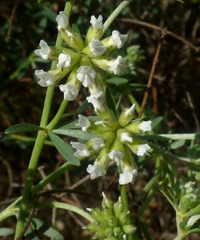Phelipanche nana

Plantae Phelipanche nana, commonly known in some regions as "Broomrape" or locally as "Rapónchigo," is a fascinating parasitic plant found in the Comunidad Valenciana and various parts of the Mediterranean. This plant belongs to the Orobanchaceae family and is notable for its unique lifestyle as it relies entirely on host plants for survival, lacking chlorophyll and the ability to photosynthesize on its own.
The following are some of the key characteristics of Phelipanche nana:
- Appearance: This species typically manifests as a small, pale-colored plant. It can range in hue from off-white to yellowish, depending on environmental conditions and host interactions.
- Size: It is generally a petite plant, often only a few centimeters tall, which makes it less conspicuous in its natural habitat.
- Flower Structure: Despite its diminutive size, Phelipanche nana bears distinctive tubular flowers. These flowers emerge in spikes and are often covered with soft hairs.
- Habitat: This species is prevalent in dry, sandy soils and can often be found in areas that experience a Mediterranean climate. It has a preference for growing on a variety of host species, from herbs to shrubs native to the region.
- Ecological Role: As a parasitic plant, it plays a unique role in the ecosystem, directly depending on the roots of nearby host plants for water and nutrients.
This plant is an excellent representation of the unique parasitic relationships found within the flora of Comunidad Valenciana, illustrating both the diversity and the complexity of plant life in this region.







